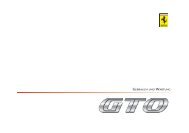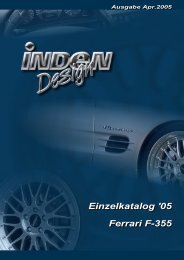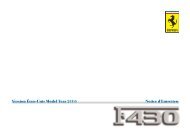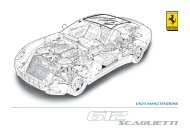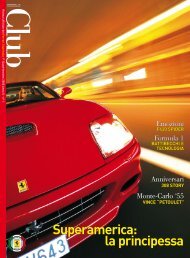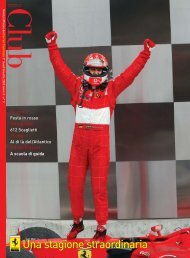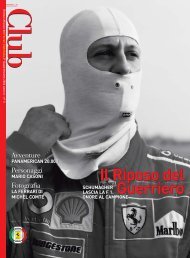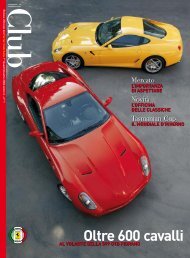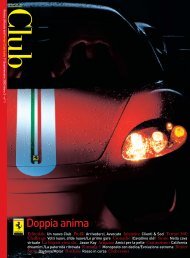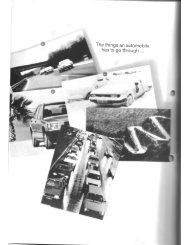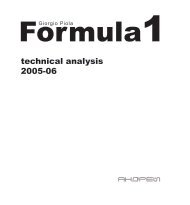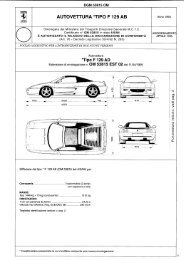- Page 1 and 2:
D CLUTCH-GEARBOX-DIFFERENTIAL D1 GE
- Page 3 and 4:
Gears Gear ratios Final reduction r
- Page 5 and 6:
Pinion/Crown backlash (on 3 points
- Page 7 and 8:
AV 3261 Tool for fitting the clutch
- Page 9 and 10:
D1.04 TIGHTENING TORQUES NOTES To c
- Page 11 and 12:
D2.01 DISMANTLING This paragraph de
- Page 13 and 14:
Electronically controlled version o
- Page 15 and 16:
• Detach the actuator's rear supp
- Page 17 and 18:
• Release the oil pipes from the
- Page 19 and 20:
• Unscrew the clutch pipe union (
- Page 21 and 22:
• In the lower part of the engine
- Page 23 and 24:
• Fasten the ends of the belt ont
- Page 25 and 26:
• Sling the gearbox as described
- Page 27 and 28:
• Lock the six nuts and the two l
- Page 29 and 30:
• Fasten the engine service cable
- Page 31 and 32:
• Re-assemble the oil coolant pip
- Page 33 and 34:
• Re-assemble the gearbox support
- Page 35 and 36:
• Replenish the engine oil ( A 3.
- Page 37 and 38:
Vehicles with the N. 63614 (type F1
- Page 39 and 40:
Starting from vehicle Ass.ly No. 53
- Page 41 and 42:
• Unscrew and remove the eight sc
- Page 43 and 44:
Therefore, for the engines installe
- Page 45 and 46:
• Lubricate the ORings (9) and th
- Page 47 and 48:
Use the tool AV 3079 to centre the
- Page 49 and 50:
NOTES Replacement of the control an
- Page 51 and 52:
to adjust the pedal into the restin
- Page 53 and 54:
NOTES On the US versions, the switc
- Page 55 and 56:
• Screw the adjusting screw (3) o
- Page 57 and 58:
( G 2.03). Tightening torques Nm Ca
- Page 59 and 60:
• Fill and drain the clutch syste
- Page 61 and 62:
• Press the clutch pedal and simu
- Page 63 and 64:
5- Press "ENTER" to activate the te
- Page 65 and 66:
D4.01 REPLACING THE EXTERNAL COMPON
- Page 67 and 68:
• Using a commercial bearing extr
- Page 69 and 70:
• Remove the left-hand side catal
- Page 71 and 72:
• Position the grommet with its c
- Page 73 and 74:
Flexible upper bushing on the gearb
- Page 75 and 76:
• Screw the nut (B) with the wash
- Page 77 and 78:
• Fit the spacers on every side o
- Page 79 and 80:
• Before fitting the new pad, che
- Page 81 and 82:
Gearshift selection levers (Mechani
- Page 83 and 84:
• Check that the equaliser (H) an
- Page 85 and 86:
• Clean the coupling surfaces of
- Page 87 and 88:
• Unscrew the three nuts and remo
- Page 89 and 90:
• Pull the two cables from the pa
- Page 91 and 92:
• Working from under the car, mak
- Page 93 and 94:
7 Check that the control lever is i
- Page 95 and 96:
In case of interference during 4th
- Page 97 and 98:
• Unscrew the four screws fasteni
- Page 99 and 100:
IMPORTANT In case of replacement of
- Page 101 and 102:
D4.04 DETACHING/RE-FITTING THE GEAR
- Page 103 and 104:
Note for the US version On these ca
- Page 105 and 106:
Support brackets for the pneumatic
- Page 107 and 108:
• Unscrew and remove the screw wi
- Page 109 and 110:
• Remove the movable frame from t
- Page 111:
• Remove the movable frame from t
- Page 114 and 115:
• Tighten screws (5), (7) and (8)
- Page 117 and 118:
D4.05 GEARBOX OVERHAUL Gearbox iden
- Page 119:
• Fix it on the housing, using th
- Page 122 and 123:
42 Lay shaft (pinion) 43 Flexible r
- Page 124 and 125:
the protective sheet for the oil-fl
- Page 126 and 127:
• Use the USAG 454N/2 extractor p
- Page 128 and 129:
• Fit the extracting tool arms US
- Page 130 and 131:
• Lock the base AV 3252 in a vice
- Page 132 and 133:
• Rivet the caulkings of the shou
- Page 134 and 135:
• Using the previously used armed
- Page 136 and 137:
• Lock the tool's support plate i
- Page 138 and 139:
odies. • To remove ball bushing (
- Page 140 and 141:
• When re-assembling, use the pun
- Page 142 and 143:
NOTES For oil pump disassembly and
- Page 144 and 145:
Starting FROM gearbox 10928, the ne
- Page 146 and 147:
and uniform. • Position this so f
- Page 148 and 149:
• When assembling the 3 rd - 4 th
- Page 150 and 151:
Unscrew the four fastening screws w
- Page 152 and 153:
Re-assembling the gearbox shaft com
- Page 154 and 155:
• Apply the recommended locking p
- Page 156 and 157: • Reset the dial gauge on the che
- Page 158 and 159: • Fit the outer race of the rear
- Page 160 and 161: • Place the lay shaft on the chec
- Page 162 and 163: • To determine the thickness (S3)
- Page 164 and 165: • Again using the gauged blocks,
- Page 166 and 167: • Fit the bushing AV 3284 in the
- Page 168 and 169: • Using punch AV 3262 and a rubbe
- Page 170 and 171: • Mount the intermediate plate us
- Page 172 and 173: D5.01 COMPONENT REPLACEMENT Differe
- Page 174 and 175: • Turn over the left-hand cover a
- Page 176 and 177: Differential crown IMPORTANT The di
- Page 178 and 179: • Re-assemble the differential un
- Page 180 and 181: • Remove the outer race of the ro
- Page 182: NOTE For positioning the pinion ( D
- Page 185 and 186: • Proceed mounting the inner race
- Page 187 and 188: NOTES The thickness of the spacers
- Page 189 and 190: • Install the components on the l
- Page 191 and 192: At this re-assembly stage, it is a
- Page 193 and 194: D5.02 AXLE SHAFT Tightening Torques
- Page 195 and 196: • Remove the screws and the shim
- Page 197 and 198: • Re-assemble the components remo
- Page 199 and 200: D6.02 GENERAL FEATURES The electron
- Page 201 and 202: D6.03 TRANSMISSION CONTROL UNIT (TC
- Page 203 and 204: D6.04 OPERATION The system is compo
- Page 205: speed depending on how the accelera
- Page 209 and 210: Keys to Fig. 2 1 - Oil tank 2 - Pum
- Page 211 and 212: • The Power Unit (A), fixed to th
- Page 213 and 214: D6.06 POWER UNIT The Power Unit is
- Page 215 and 216: • To replace the Power Unit: disc
- Page 217 and 218: •Fasten the unit onto the chassis
- Page 219 and 220: Disassembly CAUTION The hydraulic s
- Page 221 and 222: • Unscrew the nuts (9) and remove
- Page 223 and 224: The gear release device is obtained
- Page 225 and 226: 0÷5 V. NOTES We suggest you replac
- Page 227 and 228: In order to allow the sensor to det
- Page 229 and 230: • Detach the sensor's connection
- Page 231 and 232: Hydraulic Circuit Pressure Sensor (
- Page 233 and 234: The switch is placed on the door pi
- Page 235 and 236: The two push-buttons (A) and (B) ar
- Page 237 and 238: A set of warning lights indicates t
- Page 239 and 240: The clutch control is based on the
- Page 241 and 242: • With the engine running and the
- Page 243 and 244: start-up the engine. In the diagnos
- Page 245 and 246: NOTES To reassemble, follow the ope
- Page 247 and 248: Practical checks • By means of th
- Page 249 and 250: Components involved • Hydraulic p
- Page 251 and 252: This value must never exceed the cl
- Page 253 and 254: D6.13 CENTRING THE GEAR SHIFTING-SE
- Page 255 and 256: This measurement is necessary to wo
- Page 257:
• Close the "Actuator centring "



